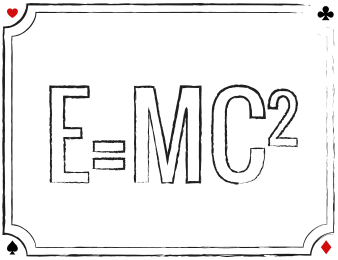What is Card Counting?
Card Counting, which is also often referred to as card reading, is a strategy which is frequently employed by blackjack players in order to determine whether the hand that is will be given out next will have a probable advantage to the player or the dealer. Typically, a card counter attempts to decrease the casino’s house edge by paying profound attention and keeping track of which cards are drawn and given to other players and as well as the dealer. By taking into account which high and low valued cards are distributed, the blackjack player is able to acquire the tell-tale signs as to which cards will be possibly drawn. Hence, if you opt to use the card counting strategy, you’ll be able to seize the opportunity and win a handsome sum of money yourself!
Card Counting Myths
MYTH: Card Counting is Illegal

You are actually using your brain to see if it is advantageous for you to play the round. You are not cheating in any way.
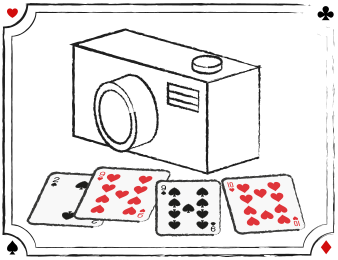
MYTH: You must have a Photographic Memory to be a Card Counter
The general public believes that a card counter memorizes every card in the deck (just like Rain Man did in the movie). The fact is that card counters don’t memorize every card. What they do is assign a “tag” to specific cards (like +1 or –1), and then add or subtract the tags as the cards appear on the layout. Card counting, in fact, requires nothing more than simple addition and subtraction (in some counting systems, a little division, too).
MYTH: You’ve got to be a Mathematical Genius in order to be a Card Counter
The movie 21 portrays card counting as an intellectually difficult task that can be learned only by top-level MIT college students with high IQs. Actually, if you have average intelligence (meaning you can read, write, and can mentally add and subtract), you can learn card counting.
MYTH: Card Counters win all the time
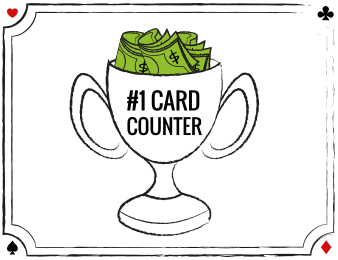
Rain Man did. So did the MIT students. Don’t believe everything you see and hear in the movies. The fact is that card counters have a small mathematical edge (roughly one-half to one percent) over the casino, and even though they will win more money than they lose over time, they certainly can’t and won’t win every time they play.
MYTH: It is impossible to count cards when the Casinos use 6 or 8 Decks of Cards
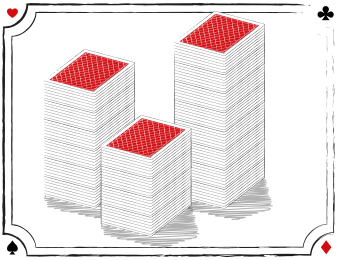
Isn’t that what the casino security person said in the Rain Man movie? Yes, he did, but it isn’t true. Remember that card counting is nothing more than mentally adding plus values and minus values, and you can do that with six and eight decks as easily as you can with a single deck of cards.
MYTH: You need tremendous Bankroll to be a Card Counter
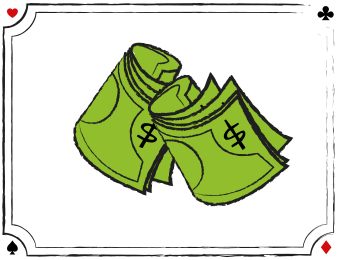
Not so. If your bankroll is meagre, you just need to play at a lower minimum bet size. What is important is that you have enough bankroll in relation to your bet size to withstand short-term losing streaks (remember, you can’t win every time you play).
MYTH: It takes a lifetime to learn Card Counting
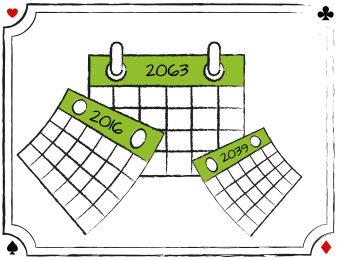
It’s true that older traditional card counting systems require a fair amount of time to master (but certainly not a lifetime). However, the newer systems that have been developed focus more on simplicity and ease of use, and although they may not have the same profit potential as a more complex counting system, they take only hours to learn by average players.

Effect of Card Removal
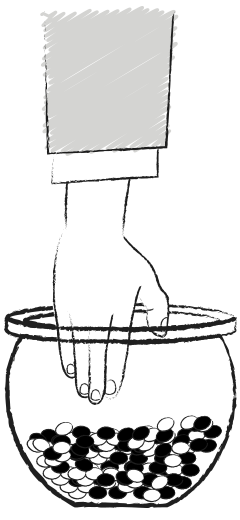 Picture a fishbowl containing 100 black marbles and 100 white marbles. You can bet as much as you want on which coloured marble you will randomly select from the bowl. You begin by betting one dollar on a white marble. You close your eyes, stick your hand into the bowl, and randomly pull out a marble. What are the odds it will be white? Obviously, the odds are 50-50 since there are equal numbers of white and black marbles in the bowl.
Picture a fishbowl containing 100 black marbles and 100 white marbles. You can bet as much as you want on which coloured marble you will randomly select from the bowl. You begin by betting one dollar on a white marble. You close your eyes, stick your hand into the bowl, and randomly pull out a marble. What are the odds it will be white? Obviously, the odds are 50-50 since there are equal numbers of white and black marbles in the bowl.
Suppose you picked a white marble on your first try. Congratulations!
We’ll set aside that white marble, and now you get to pick again. You bet another dollar on white. Pause. What are your chances of picking another white marble the second time? If you said 50-50 you are wrong. That’s because on the second pick there is one more black marble in the bowl than white. (Remember, we removed one white marble on the first pick.) The odds of picking a white marble on the second try are no longer 50-50. In fact, you would have had a 0.5% advantage if you bet on a black marble on your second pick (because there were 100 black and 99 white marbles in the bowl). Of course, that doesn’t mean you are guaranteed to win, because your edge is small. But if you were a smart player in this game, you would have bet on a black marble for your second pick.
Furthermore, you’d track the marbles as they were selected and removed from one round to the next. There may be a point when there will be a large imbalance of black vs. white marbles in the bowl or it could swing the other way (more white than black marbles). It doesn’t matter because as long as you carefully track the balls being selected, you’ll know beforehand which marble is the better bet; and, by the way, that would be a good time to bet more than a dollar. Do you get the point of how you can “beat” this marble game by keeping track of the balls being selected to give you information going forward on which ball has the better odds of being picked?
The above game is an example of a dependent-trial process because the odds change depending on what marbles were selected in previous picks. Blackjack is also a dependent-trial process game, only it’s not played with marbles but with playing cards.

Card Removal in Blackjack
Suppose you sit down at a single-deck blackjack game with two other players and during the first round after the shuffle, you notice that four aces were played. What are your chances of getting a blackjack on the second round? How much would you bet on the second round?
Because all four aces in the deck have been removed in the first round, your chance of getting a blackjack in the second round is 0; therefore, if you were a smart, observant player, you would bet the minimum in round two. (On the other hand, if no aces appeared in round one, it would have been wise to bet more money in round two because you had a greater chance of getting a blackjack and a bonus payout.)
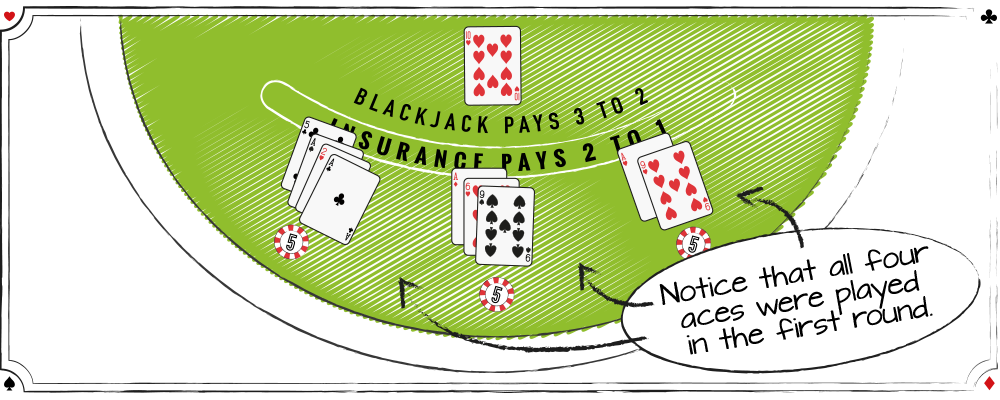
The point is this: the odds in blackjack are not static from one round to the next; the odds change depending on what cards were played (and removed) in previous rounds. The effect of removing aces is fairly obvious but what about the other cards? Do they have the same importance when taken out of play?
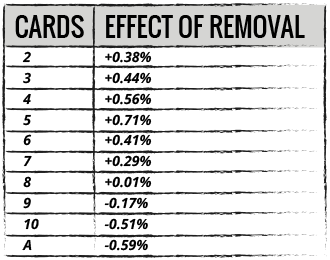
What would happen if we removed, say, an ace and a 5? To a good approximation, we can add the resulting effects of each card to determine the net effect: (−0.59%) + (+0.71%) = +0.12%. In other words, the removals of an ace and a 5 nearly cancel each other, leaving us almost right back where we started.

If you glance again at the table, you can see that the small cards all have a positive effect when they are removed from play and the 10s and aces have a negative effect. Also, the removal of a 5 has a much greater effect than the removal of an 8. Any card counting system has to somehow accurately reflect the different strengths of the cards.

KEY TAKEAWAYS
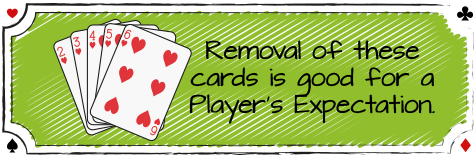 |
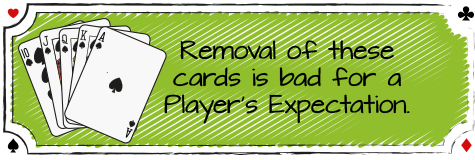 |
- Blackjack is a dependent-trial process game.
- Removal of small cards (2 through 6) has a positive effect on a player’s expectation.
- Removal of large cards (10s and aces) has a negative effect on a player’s expectation.
- Removal of some cards (e.g., a 5) has a much greater effect on a player’s expectation than the removal of other cards (e.g., an 8).
- The effects of the removal of several cards on a player’s expectation are additive.
- Any card counting system has to accurately reflect the different “strengths” of the cards as they are removed from the deck(s).
How Card Counting Works in Blackjack
After the dealer shuffles the cards, there are an equal number of small and large cards in the deck(s). During the play of a shoe, the composition of the unplayed cards changes. By tracking the depletion of small and large cards, card counters know when the relative composition of the unplayed cards is richer in large or small cards. When the deck becomes richer in large cards, the card counter has the edge and he bets more. Likewise, when the deck becomes richer in small cards, the card counter doesn’t have the advantage; therefore, he bets small. Mathematicians developed card counting systems as a tool that players can use to determine when they have the edge (and should bet more). The first systems that were developed assigned a value, or tag, to each card. For example, one system known as Hi-Lo assigns:
- A tag of +1 (that’s “plus” one) to every 2, 3, 4, 5, and 6 ranked card (small cards) to reflect the fact that removal of any of these cards will have a positive effect on a player’s expectation.
- Likewise, the 10s and Aces group (large cards) are assigned a tag of –1 (“minus” one), because their removal from the deck(s) is harmful to the player.
- Since the removal of the 7, 8, and 9 has a much lesser effect on a player’s expectation (compared to the removal of other cards), they were assigned a tag of 0 (meaning these cards could be ignored while card counting).
Card counters then arithmetically add the tags of each card that they see on the layout to arrive at an arithmetic sum (known as the “running count”).
For example, suppose player #1 has a two-card hand consisting of a 6 and a 4 and then draws a 10 for a 20. A card counter would add the tags for each of the cards to arrive at the sum of +1 (again, this is known as the running count).
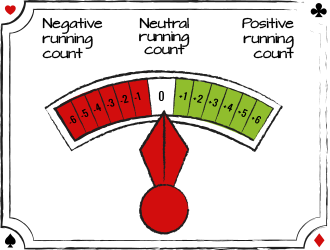
Note that because the tag for a 10 is –1, you must subtract 1 from your running count. Remember your rules for adding positive and negative numbers. A card counter will continue to mentally add the tags of the small and large cards as the cards are exposed. The player carries over the running count from one round to the next. At the end of each round, the counter will have either a positive running count, a negative running count, or possibly 0. Let’s pause for a second to reflect on what this means.
Suppose the running count is positive after the first round of play. What does this tell the card counter? In order for the running count to be a positive number, there must have been more small cards played in the previous round than large cards (remember the small cards have a tag of +1 and the big cards have a –1 tag). If that’s the case then the opposite must be true for the undealt cards; namely, they must contain more large cards than small cards.
Let’s recap.
- If your running count is positive, then the undealt cards are richer in large cards, and the card counter has the edge.
- If the running count is negative, the undealt cards are richer in small cards, and the card counter does not have the edge.
- If the running count is 0, there are an equal number of small and large cards in the unplayed cards and the deck is considered neutral (as it is at the top of a deck after a shuffle).
Card counters indirectly have knowledge of the ratio of large cards to small cards on the next deal by keeping track of all the cards that were played in the previous rounds. (I hope you are pleasantly surprised to see how card counters track cards. They aren’t memorizing every card — a myth — but only mentally adding the +1 and –1 tags assigned to each card that reflect its effect on a player’s expectation when they are removed.)
Card counters then use their count to vary their bets on the next hand as follows:
- They INCREASE their bet size when the running count is POSITIVE (because the undealt cards are richer in large cards), and
- DECREASE their bet size when the running count is NEGATIVE (because the unplayed cards are richer in small cards).
Card counters gain the upper hand over the casinos because:
- They will bet more money on positive counts (when they have the edge), and
- They will bet less money bet on negative counts (when the casino has the edge).
Here’s another point to keep in mind.
- Counters actually lose more hands than they win but they win more money than they lose, in aggregate.
How do they accomplish this?
- They have a lot more bet on the hands that they win compared to the amount of money bet on the hands that they lose. It’s that simple.
If you are still thinking, “Won’t the dealer have just as much chance to get the big cards as I will,” the answer is yes, but as mentioned earlier, players can double down, pair split, get paid 3 to 2 on blackjacks, take insurance when it’s offered, and unlike the dealer, don’t have to hit a hard 12 through 16 when the undealt cards are richer in large cards. This is what creates the basic edge that card counters have over the casino when the count is positive, and this is how card counters can beat the game of blackjack.
Card Counting Techniques
The High-Lo System
+1 for the small cards and −1 for the large cards.
One of the most profitable, and maybe the simplest way to count cards, is by using the Hi-Lo strategy. The system is basically a running count technique where every card is assigned a specific value. The system is used to distinguish when the ratio of high value- and low-value cards in the blackjack decks is unbalanced.
High-value cards like tens and aces will not only increase the chance of blackjacks being dealt, but also hands totalling to 20. A deck containing a majority of high-value cards is a very profitable situation for the player, as it increases the chance of the dealer going bust. In other situations, where the majority of the remaining cards in the deck are low-value cards, all cards 2-6, the dealer will have a substantial edge over the player. The fact that the dealer must draw on hard hands (12 through 16) will, in a situation where a lot of low-value cards are remaining in the deck, reduce the chances of the dealer going bust when drawing another card. If there are a lot of high-value cards (tens and aces) in the deck, the probability of the dealer going bust is significantly greater.
The True Count
A second factor to consider when you are trying to determine the balance of the blackjack deck is the number of remaining cards in the deck. As we stated earlier, the closer you get to the bottom of the deck, the more accurate your count will be. By dividing your running count with the approximate numbers of remaining decks you will get a more correct count – or the “true count”.
Converting your running count into a true count will make your count a lot more accurate. Now, this can be a bit tricky, but if you practice using several decks you will soon be able to visually estimate how many decks are left in the shoe. Let’s say that your running count is +4, and you estimate the remaining decks in the shoe to be 2, then your true count should be +4 / 2 =+ 2.
If your count still shows a positive result after you have implemented the true count system to your running count, you’ll have a good chance of making a good profit by increasing your bet size. The true count number is a more accurate indicator of how favourable/unfavourable the deck really is.
More Complex Counting Systems
As long as card counting has been around, there have always been people trying to improve and refine different card counting techniques. However, we have learned from experience that the simpler your system is, the easier it will be to practice. Even if you think that you fully master a complex and very accurate counting system, it will not make you any more money in the long run.
The disadvantages of more complex systems like side-counts and multi-level systems are that when you are trying to keep track of a lot more information it will detract from your ability to play fast and count accurately. You will earn more money by playing a straightforward count faster than by playing a more complex one slowly. The less effort you put into counting, the more you can spend on steering clear of the casino security radar.
Back Counting or Wonging
One of the most famous card counting techniques is called “Wonging”, named after the pseudonym Stanford Wong, used by John Ferguson when writing his series of blackjack books. The name “Wonging” referrers to his technique of observing Blackjack tables, counting the deck pretty much as described above, but moving into the game only when the card count was in favour of the player. Using this technique will reduce your “operating cost” i.e. you don’t pay anything until when you sit down at a “hot” table. This technique, however, is well known today and a floor manager will have no trouble detecting such behaviour around the tables. Furthermore, many casinos no longer allow “mid-shoe entry” in Blackjack games.
The obvious advantage of back-counting systems like for example wonging, is that the player does not have to play every hand that he or she counts. This will reduce fluctuations in your bankroll and therefore increase the player’s edge even more.
Why Simple Count Systems are more Profitable
For reasons already mentioned, multifaceted counting systems are obviously a lot more detectable for casino employees than simple, straightforward systems. A group of counters playing together as a team are easily noticeable for “eye-in-the-sky” personnel. Signs and codes are, even if you think that they will go by unnoticed, most of the time picked up by the surveillance cameras – if not at once, then surely afterwards when security people review the tapes.
In contrast, cameras will never be able to pick up what goes on inside the mind of a player, and that is probably the best reason for why the high-tech casinos of today still have trouble spotting the most successful card counters. The minute you take your system outside your head and include outside assistance that can leave tracks for the casino to pick up is when you risk detection. Most casinos try to spot card counters by observing irregularity in betting patterns, both manually and with the help of technology. If you are using a simple counting system, you can concentrate on covering up your tracks, by for example communicating with people around the table, and adjusting your betting pattern so that it won’t be of any reason for suspicion.
Does Card Counting work on Gambling Sites?
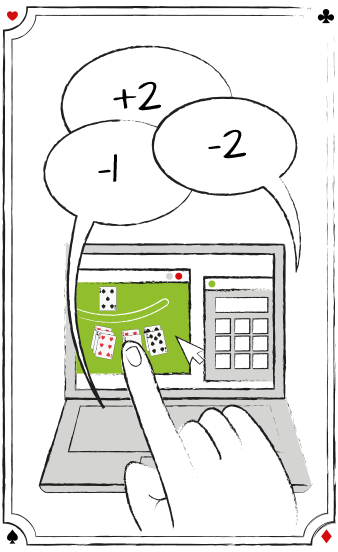
For the most part, no. The reason is that the majority of online web sites shuffle the cards after each hand, making card counting impossible. However, there are some online gambling sites that offer multi-deck games with a cut card. The issue here is that most deal only about 50% of the cards then reshuffle. You need to check the site’s instructions/rules for information on when the cards are reshuffled (or call the site’s customer service department and ask them). If the site reshuffles after 50% (or more) of the cards are dealt, then card counting is viable. (But don’t hold your breath on this, because it’s rare that a site will deal more than 50% of the cards. But even with a 50% cut, you’ll have a slight edge with card counting assuming the playing rules are fair.


